现在时,过去时,未来时的单词对比
- 格式:xlsx
- 大小:7.84 KB
- 文档页数:1
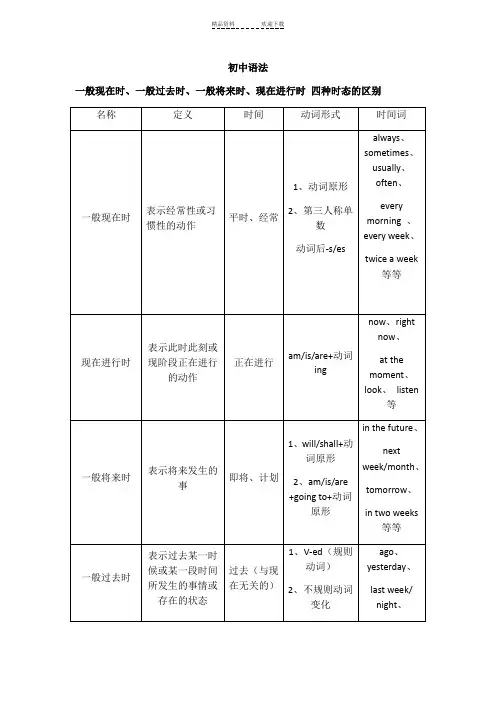
初中语法一般现在时、一般过去时、一般将来时、现在进行时四种时态的区别注意:1、一般现在时——第三人称单数的动词变化规则:1)大多数动词在词尾加“S”如:stop-______ ; make-______ read-______ ; play-______2)以辅音字母加“y”结尾的,要先将“y”变为“i”,然后在加“es”如:fl y-______ ;carr y-______ stud y-______ ; worr y-______3)以“s, x, ch, sh”结尾的,在词尾加“es”如:tea ch-______ ; wat ch-______4)以“o”结尾的动词,加“es”如:go-______ do-______2、现在进行时——动词ing形式的变化规则1.一般动词直接在词尾+ing例:read→______ (读)talk→______(交谈)sing→______(唱歌)2.以不发音e结尾的动词,先去e再加ing例:lik e→______喜欢writ e→______写skat e→______(滑冰)3.以重读闭音节结尾且末尾只有一个辅音字母的动词,双写末尾字母,再加ing 例:sto p→______(停止)ge t→______(得到)4.少数几个以ie结尾的动词,变ie为f再加ing。
例:l ie→______(躺、撒谎)t ie→______(系、捆绑)3、一般过去时——动词的变化规则(1) 一般在动词后加-ed。
如:play-______, offer-______, weigh-______, destroy-______, sign-______(2) 在以字母e结尾的动词后,只加-d。
如:lik e-______, provid e-______, hat e- ______ dat e-______(3) 在以“辅音字母+y”结尾的动词后,则改y为i,再加-ed。
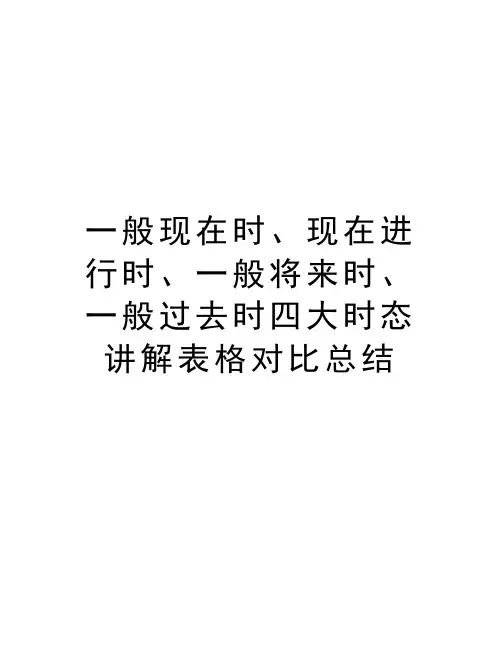
一般现在时、现在进行时、一般将来时、一般过去时四大时态讲解表格对比总结四大时态总结--------一般现在时、一般将来时、一般过去时、现在进行时一、一般现在时一般现在时表示经常性或习惯性的动作,常与表示频度的时间状语连用,如often, usually, always, sometimes, never, seldom, every week/day/year/month..., once a week, on Sundays等。
动词用原形。
当主语第三人称单数的动词变化规则:(只有在第三人称(he, she, it, 一个人名)为主语的肯定句中,动词才用三单式)(1)一般情况下,直接加s runs gets likes(2)结尾是s, x, sh, ch, o,前为辅音字母,结尾加es watches, goes, washes, crosses, mixes, does(3)动词末尾y,前为辅音,将y改为i加es study→studies fly→flies但在y前如果为元音则直接加s buys says plays(4)不规则变形 have—has二、现在进行时现在进行时表示此时此刻或现阶段正在进行的动作。
常与now, at this time, these days, Listen! Look! at(1)直接在动词后加ing. going, starting, working.(2)去掉词尾不发音的e,再加ing. leave--leaving, make---making.注意:如果单词结尾的e发音,则不能去掉,也直接加ing. see –seeing agree - agreeing .(3) 对于动词只有一个元音,而其后跟了一个辅音字母时,双写末尾辅音字母再加ing.sitting, beginning run – running stop – stopping cut – cutting control – controlling(4)以ie结尾,把ie变y再加ing。
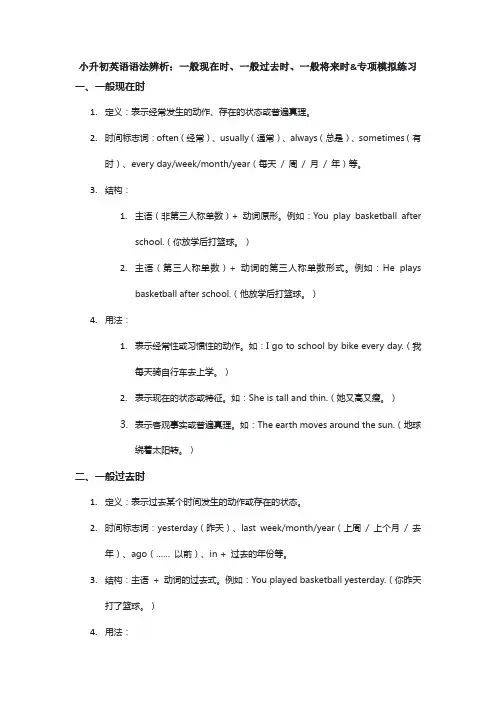
小升初英语语法辨析:一般现在时、一般过去时、一般将来时&专项模拟练习一、一般现在时1.定义:表示经常发生的动作、存在的状态或普遍真理。
2.时间标志词:often(经常)、usually(通常)、always(总是)、sometimes(有时)、every day/week/month/year(每天/ 周/ 月/ 年)等。
3.结构:1.主语(非第三人称单数)+ 动词原形。
例如:You play basketball afterschool.(你放学后打篮球。
)2.主语(第三人称单数)+ 动词的第三人称单数形式。
例如:He playsbasketball after school.(他放学后打篮球。
)4.用法:1.表示经常性或习惯性的动作。
如:I go to school by bike every day.(我每天骑自行车去上学。
)2.表示现在的状态或特征。
如:She is tall and thin.(她又高又瘦。
)3.表示客观事实或普遍真理。
如:The earth moves around the sun.(地球绕着太阳转。
)二、一般过去时1.定义:表示过去某个时间发生的动作或存在的状态。
2.时间标志词:yesterday(昨天)、last week/month/year(上周/ 上个月/ 去年)、ago(……以前)、in + 过去的年份等。
3.结构:主语+ 动词的过去式。
例如:You played basketball yesterday.(你昨天打了篮球。
)4.用法:1.表示过去某个时间发生的动作。
如:I went to the park last Sunday.(我上周日去了公园。
)2.表示过去存在的状态。
如:He was happy yesterday.(他昨天很开心。
)三、一般将来时1.定义:表示将来某个时间要发生的动作或存在的状态。
2.时间标志词:tomorrow(明天)、next week/month/year(下周/ 下个月/ 明年)、in the future(在未来)等。
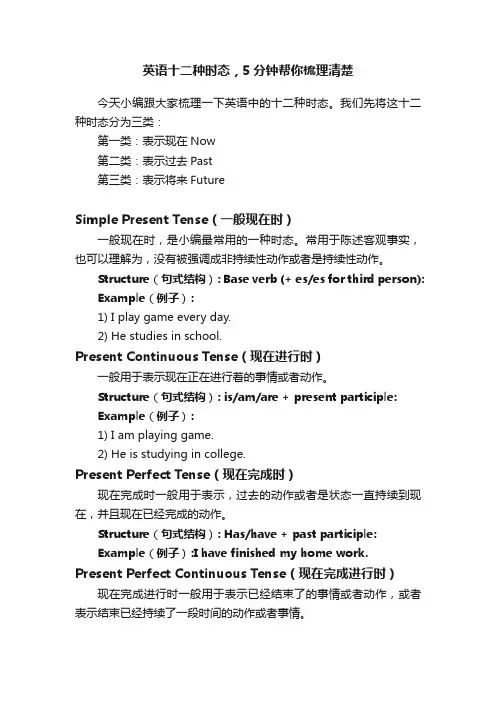
英语十二种时态,5分钟帮你梳理清楚今天小编跟大家梳理一下英语中的十二种时态。
我们先将这十二种时态分为三类:第一类:表示现在Now第二类:表示过去Past第三类:表示将来FutureSimple Present Tense(一般现在时)一般现在时,是小编最常用的一种时态。
常用于陈述客观事实,也可以理解为,没有被强调成非持续性动作或者是持续性动作。
Structure(句式结构): Base verb (+ es/es for third person): Example(例子):1) I play game every day.2) He studies in school.Present Continuous Tense(现在进行时)一般用于表示现在正在进行着的事情或者动作。
Structure(句式结构): is/am/are + present participle:Example(例子):1) I am playing game.2) He is studying in college.Present Perfect Tense(现在完成时)现在完成时一般用于表示,过去的动作或者是状态一直持续到现在,并且现在已经完成的动作。
Structure(句式结构): Has/have + past participle:Example(例子):I have finished my home work. Present Perfect Continuous Tense(现在完成进行时)现在完成进行时一般用于表示已经结束了的事情或者动作,或者表示结束已经持续了一段时间的动作或者事情。
Structure(句式结构): Has/have + been + present participle:Example(例子):1) I have been finishing my home work for the last two hours.2) He has been studying in school since his childhood.Simple Past Tense(一般过去时)一般过去时一般用于表示在过去的时候发生过了的动作,或者在过去的时候有过的状态。
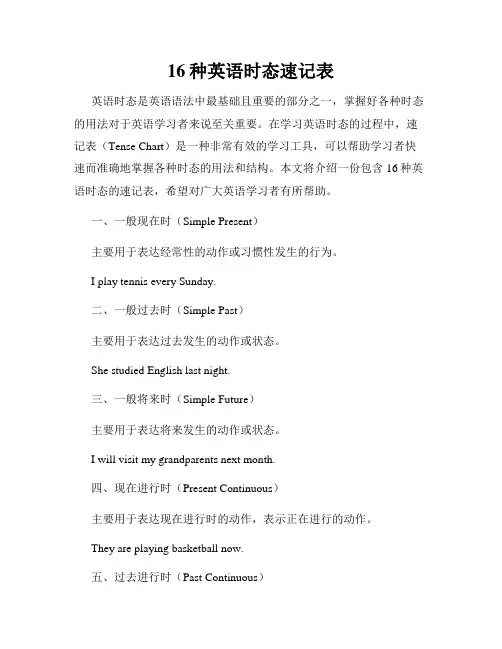
16种英语时态速记表英语时态是英语语法中最基础且重要的部分之一,掌握好各种时态的用法对于英语学习者来说至关重要。
在学习英语时态的过程中,速记表(Tense Chart)是一种非常有效的学习工具,可以帮助学习者快速而准确地掌握各种时态的用法和结构。
本文将介绍一份包含16种英语时态的速记表,希望对广大英语学习者有所帮助。
一、一般现在时(Simple Present)主要用于表达经常性的动作或习惯性发生的行为。
I play tennis every Sunday.二、一般过去时(Simple Past)主要用于表达过去发生的动作或状态。
She studied English last night.三、一般将来时(Simple Future)主要用于表达将来发生的动作或状态。
I will visit my grandparents next month.四、现在进行时(Present Continuous)主要用于表达现在进行时的动作,表示正在进行的动作。
They are playing basketball now.五、过去进行时(Past Continuous)主要用于表示过去某个时间点正在进行的动作。
I was studying when she called.六、将来进行时(Future Continuous)主要用于表示将来某个时间点正在进行的动作。
They will be cooking dinner at 8 o'clock.七、现在完成时(Present Perfect)主要用于强调动作对现在的影响或与现在有关的动作。
I have finished my homework.八、过去完成时(Past Perfect)主要用于表示在过去某个时间点之前完成的动作。
She had already left when I arrived.九、将来完成时(Future Perfect)主要用于表示将来某个时间点之前已经完成的动作。
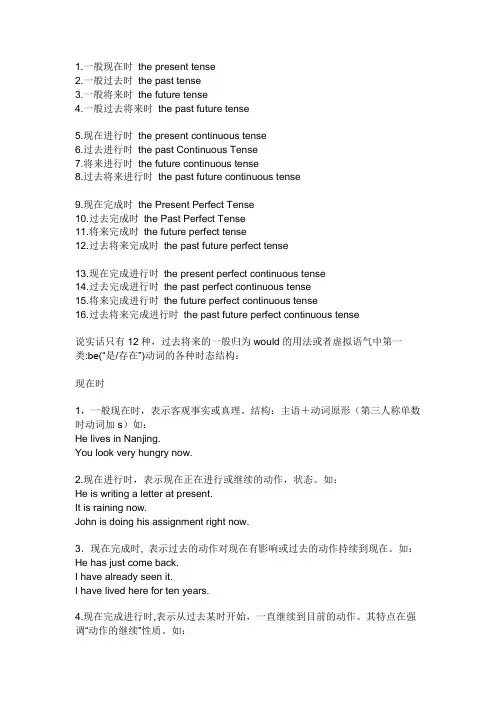
1.一般现在时the present tense2.一般过去时the past tense3.一般将来时the future tense4.一般过去将来时the past future tense5.现在进行时the present continuous tense6.过去进行时the past Continuous Tense7.将来进行时the future continuous tense8.过去将来进行时the past future continuous tense9.现在完成时the Present Perfect Tense10.过去完成时the Past Perfect Tense11.将来完成时the future perfect tense12.过去将来完成时the past future perfect tense13.现在完成进行时the present perfect continuous tense14.过去完成进行时the past perfect continuous tense15.将来完成进行时the future perfect continuous tense16.过去将来完成进行时the past future perfect continuous tense说实话只有12种,过去将来的一般归为would的用法或者虚拟语气中第一类:be(“是/存在”)动词的各种时态结构:现在时1,一般现在时,表示客观事实或真理。
结构:主语+动词原形(第三人称单数时动词加s)如:He lives in Nanjing.You look very hungry now.2.现在进行时,表示现在正在进行或继续的动作,状态。
如:He is writing a letter at present.It is raining now.John is doing his assignment right now.3.现在完成时, 表示过去的动作对现在有影响或过去的动作持续到现在。
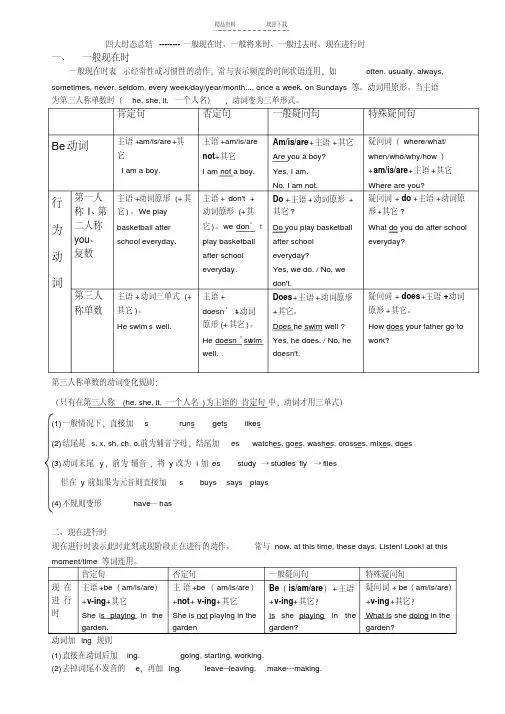
四大时态总结--------一般现在时、一般将来时、一般过去时、现在进行时一、一般现在时一般现在时表示经常性或习惯性的动作,常与表示频度的时间状语连用,如often, usually, always, sometimes, never, seldom, every week/day/year/month..., once a week, on Sundays等。
动词用原形。
当主语为第三人称单数时(he, she, it, 一个人名),动词变为三单形式。
肯定句否定句一般疑问句特殊疑问句Be动词主语+am/is/are+其它I am a boy.主语+am/is/arenot+其它I am not a boy.Am/is/are+主语+其它Are you a boy?Yes, I am.No, I am not.疑问词(where/what/when/who/why/how)+am/is/are+主语+其它Where are you?行为动词第一人称I、第二人称you、复数主语+动词原形(+其它)。
We playbasketball afterschool everyday.主语+ don't+动词原形(+其它)。
we don’tplay basketballafter schooleveryday.Do +主语+动词原形+其它?Do you play basketballafter schooleveryday?Yes, we do. / No, wedon't.疑问词+do +主语+动词原形+其它?What do you do after schooleveryday?第三人称单数主语+动词三单式(+其它)。
He swim s well.主语+doesn’t+动词原形(+其它)。
He doesn’tswimwell.Does +主语+动词原形+其它。
Does he swim well ?Yes, he does. / No, hedoesn't.疑问词+ does +主语+动词原形+其它。

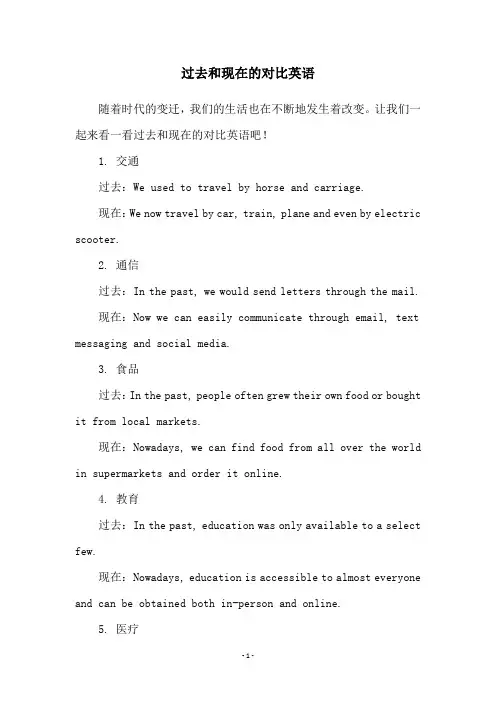
过去和现在的对比英语随着时代的变迁,我们的生活也在不断地发生着改变。
让我们一起来看一看过去和现在的对比英语吧!1. 交通过去:We used to travel by horse and carriage.现在:We now travel by car, train, plane and even by electric scooter.2. 通信过去:In the past, we would send letters through the mail.现在:Now we can easily communicate through email, text messaging and social media.3. 食品过去:In the past, people often grew their own food or bought it from local markets.现在:Nowadays, we can find food from all over the world in supermarkets and order it online.4. 教育过去:In the past, education was only available to a select few.现在:Nowadays, education is accessible to almost everyone and can be obtained both in-person and online.5. 医疗过去:In the past, medical treatments were often limited and inaccessible.现在:Now, medical technology has greatly advanced and we have access to a wide range of treatments and medicine.以上就是过去和现在的对比英语,让我们一起感受时代的变迁吧!。
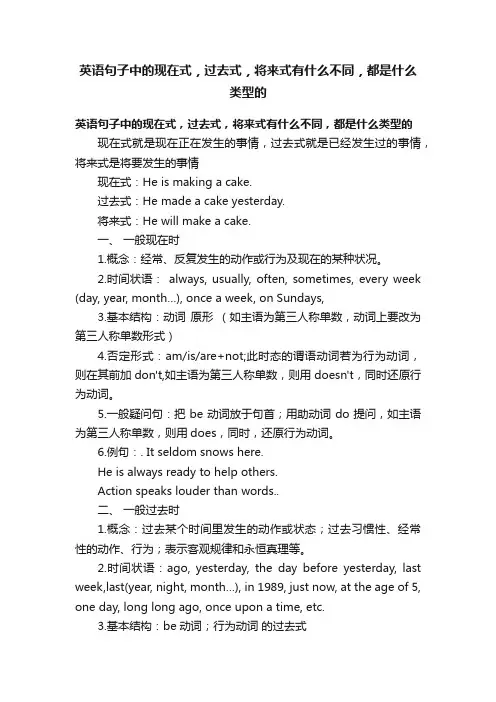
英语句子中的现在式,过去式,将来式有什么不同,都是什么类型的英语句子中的现在式,过去式,将来式有什么不同,都是什么类型的现在式就是现在正在发生的事情,过去式就是已经发生过的事情,将来式是将要发生的事情现在式:He is making a cake.过去式:He made a cake yesterday.将来式:He will make a cake.一、一般现在时1.概念:经常、反复发生的动作或行为及现在的某种状况。
2.时间状语:always, usually, often, sometimes, every week (day, year, month…), once a week, on Sundays,3.基本结构:动词原形(如主语为第三人称单数,动词上要改为第三人称单数形式)4.否定形式:am/is/are+not;此时态的谓语动词若为行为动词,则在其前加don't,如主语为第三人称单数,则用doesn't,同时还原行为动词。
5.一般疑问句:把be动词放于句首;用助动词do提问,如主语为第三人称单数,则用does,同时,还原行为动词。
6.例句:. It seldom snows here.He is always ready to help others.Action speaks louder than words..二、一般过去时1.概念:过去某个时间里发生的动作或状态;过去习惯性、经常性的动作、行为;表示客观规律和永恒真理等。
2.时间状语:ago, yesterday, the day before yesterday, last week,last(year, night, month…), in 1989, just now, at the age of 5, one day, long long ago, once upon a time, etc.3.基本结构:be动词;行为动词的过去式4.否定形式:was/were+not;在行为动词前加didn't,同时还原行为动词。
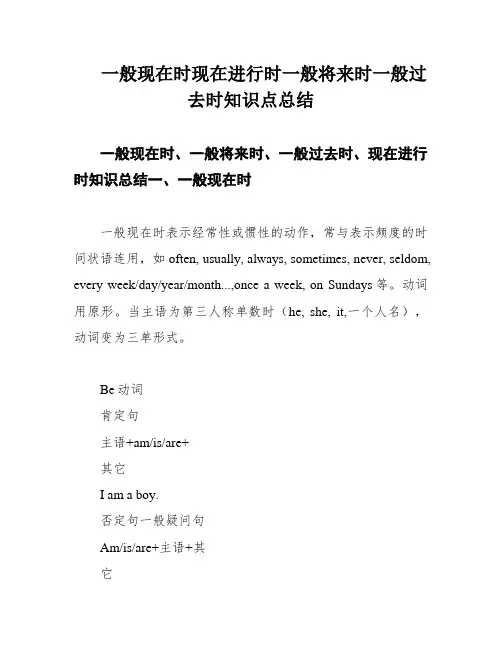
一般现在时现在进行时一般将来时一般过去时知识点总结一般现在时、一般将来时、一般过去时、现在进行时知识总结一、一般现在时一般现在时表示经常性或惯性的动作,常与表示频度的时间状语连用,如often, usually, always, sometimes, never, seldom, every week/day/year/month...,once a week, on Sundays等。
动词用原形。
当主语为第三人称单数时(he, she, it,一个人名),动词变为三单形式。
Be动词肯定句主语+am/is/are+其它I am a boy.否定句一般疑问句Am/is/are+主语+其它Are you a boy? Yes, I am.No, I am not.Do+主语+动词原形+其它?Do you play basketball after school everyday? Yes, we do. / No, we don't.Does+主语+动词原形+其它。
Does he swim well ? Yes, he does. / No, XXX't.非凡疑问句疑问词(where/what/ when/who/why/how)+am/is/are+主语+别的Where are you?疑问词+do+主语+动词真相+别的?What do you do afterschool everyday?主语+am/is/arenot+别的I am not aXXX.第一人主语+动词原形(+主语+don't+行称I、第其它)。
We play动词原形(+其它)。
wedon’t为二人称basketball afteryou、XXX.playbasketball动复数after schoolXXX.词第三人主语+动词三单主语+称单数式(+别的)。
doesn’t+动词真相(+其XXX.它)。
XXX’tswim well.疑问词+does+主语+动词原形+其它。
关于三个时态过去、现在、未来时态解说语法是在学习英语中的一个基础,基础的东西会为了我们打造一个更好的学习效果,以下是我给大家整理的关于三个时态过去、现在、将来时态解说,盼望可以帮到大家一般过去时的用法一1)在确定的过去时间里所发生的动作或存在的状态。
时间状语有:yesterday, last week, an hour ago, the other day, in 1982等。
Where did you go just now?2)表示在过去一段时间内,常常性或习惯性的动作。
When I was a child, I often played football in the street.Whenever the Browns went during their visit, they were given a warm welcome.3)句型:It is time for sb. to do sth到时间了该了It is time sb. did sth. 时间已迟了早该了It is time for you to go to bed.你该睡觉了。
It is time you went to bed.你早该睡觉了。
would (had) rather sb. did sth.表示宁愿某人做某事Id rather you came tomorrow.4) wish, wonder, think, hope 等用过去时,作摸索性的询问、恳求、建议等。
I thought you might have some. 我以为你想要一些。
比较:一般过去时表示的动作或状态都已成为过去,现已不复存在。
Christine was an invalid all her life.(含义:她已不在人间。
)Christine has been an invalid all her life.(含义:她现在还活着)Mrs. Darby lived in Kentucky for seven years.(含义:达比太太已不再住在肯塔基州。
一般现在时、一般过去时与一般将来时的对比一、时态总结三.用动词的正确形式填空.1.I ______________ (be not) a middle school student. 2.Sam and I______________ (be) in different classes .3. ______________ you ______________ (have) a new watch?4. She______________ (make) a call to her parents once a week.5. It’s nine o’clock. It's time ______________ (play) games.6. I want ______________ (take) some books to the classroom.7. It's snowing now. We can go out and ______________ (play) in the snow.8. The men ______________ (work) near the house now.9. Look! The teachers ______________ (talk) to the students.10. It is true that the sun (rise) in the east and (fall) down in the west.11. I ______________ (leave) my jacket at your home just now.12. He______________ (be) born in 1982.13. Where ______________ your brother______________ (come) from?14. Bill ______________ (stay) at home every Sunday.15. I can ______________ (help) you to ______________ (carry) the things.16. Where ______________ you ______________ (go) tomorrow?17. Mike often______________ (read) English in the morning.He ______________ (like) ______________ (read) very much.18. ______________ they ______________ (speak) Japanese? Yes, they do.19. ______________ you ______________ (have) a good time at the cinema last night?20. There______________ (be) a meeting next week.21. Listen! Who ______________ (sing) next room?22. My father ______________ ( work) in the factory three years ago.23. He ______________ (not be) at school yesterday because he ______________ (be) ill.24. ______________ (be) there any water in the glass?25. He with his friends usually ______________ (play) football after school.四、根据首字母提示或所给中文完成下列句子:1.Don’t ______________ (打开) the door. It’s very cold.2.What are you ______________ (写), Betty?3.Guangzhou is one of the most modern(现代的) and beautiful ____________(城市) in China.4.__________ (课) Three is very hard. You must listen to the teacher _____________ (认真).5.They’re ______________ (来自) England.6.Tom is from______________ (美国) and he’s ______________ (美国人).7.What’s Jack’s ___________ _____________(姓)?8.Peter can talk a_____________ jobs in English.9.Sam and Betty b_____________ speak English.10.Linda can play basketball and r____________ a bike.11.My _____________(父母) take me to (拜访) my uncle every year.12.The tall _______________(建筑物) over there is the gym.13.Please ________________(欢迎) Betty and Tony to our school.14.My father is a teacher at Beijing ________________(国际的) school.五.用下面所给词的正确形式完成下列句子:be there behind dictionary some there bee-mail have got in one’s family make there be1. Are there __________________ maps on the wall in your classroom?2. _______________ many books in our school library.3. ________________ an English book on the teacher’s desk?4. The gym is ___________ the offices.5. Are there any __________________ in your bookshop?6. ___________________ any juice in the bottle?7. Here are some ______________ for you.8. Bill _________________ a small family.9. She has got eight people __________________.10. It’s eleven o’clock now. They ______________ kites. They’re going to fly kites next Saturday.六.阅读短文,从各题所给的A、B、C和D四个选项中,选出可以填入空白处的最佳答案。
标志性词语:1.一般现在时态:often(经常), usually(通常), always(经常), seldom(很少)every day/week/month/year每天/周/月/年, sometimes(有时), never(从不) once a week(一周一次), twice a week(一周两次), on Sundays(星期天)等。
2.一般过去时态:Yesterday(昨天), the day before yesterday(前天)last week(上个星期) last month (上个月)last year(去年)two months ago(两个月之前),in 1990, in those days(那些日子) , long long ago=once upon a time(很久以前)just now(刚才) at the age of 53.现在进行时态:Now(现在), at the moment(此刻). It’s four o’clock(四点钟). Nowadays (如)Look!. Listen!when(当) while(当)等引导的时间状语从句。
4.过去进行时态:at that time(那时) yesterday(昨天), at that moment(那时) at eight o’clock last night(昨晚八点), from8 to 10 yesterday morning (昨天早上的八点到十点), when(当), while(当)等引导的时间状语从句等。
(1) tomorrow(明天), the day after tomorrow(后天), tomorrow morning(明早)(2) next time(下次), next Friday(下周五),next term(下学期), next month (下个月)(3) soon = right away = at once (4) in the future (将来)1. Look! Someone ______ in the next room .A. dancedB. dancingC. is dancingD. has danced2.Our teacher told us the sun ______ bigger than the earth.A. isB. wasC. areD. will be3. I’m afraid you can’t sit here. ------Sorry, I ______ notice.A. don’tB. won’tC. can’tD. didn’t4. When she ______ the magazine(杂志), her dad ______ asleep.A. read, was fallingB. was reading, fellC. was reading, was fallingD. read, fell5. Jim is not coming tonight.------But he______ !A. promises(许诺)B. promisedC. will promiseD. was promising6.Mary often ______ her dresses on weekends.A. washingB. washesC. has washedD. wash7. I’m Chinese. Where ______ from?A. do you comeB. you are comingC. you comeD. are you coming8. Tom and his brother ______to school.A. never walkB. are never walkingC. walk neverD. never are walking9 .It______ hard when I left my house .A. is rainingB. rainsC. was rainingD. will rain10.I think this question ______to answer.A. easyB. is easyC. was easyD. will easy11. Don’t talk so loudly . Your father ______.A. sleepsB. is sleepingC. sleptD. had slept12. Maths______always interested(使……感兴趣)him.A. hasB. haveC. areD. isst week John ______his leg.A. felt and brokenB. fell and brokeC. feels and breaksD. fallen and broken14. Jack ______his thick coat because it was snowing.A. puts onB. put onC. takes onD. took on15. He ______the picture on the wall.A. hangedB. hungC. has hangedD. was hanged16. Next month ______twenty five.A. has my sisterB. my sister will beC. my sister shall haveD. my sister is going to be17. You ______her again in a few weeks.A. will seeB. is going to seeC. sawD. will be going to see18. When______, I’ll talk to him.A. does Peter comeB. Peter will comeC. Peter comesD. can Peter come19.My sister ______to see me. She’ll be here soon.A. comesB. is comingC. had comeD. came20.—What do you do?—I’m an engineer. I __ in a company in Wuhan. I like my job very much.A. workB. had workedC. will workD. worked21.—Is your father a doctor? —Yes, he is. He__________ in Town Hospital.A. has workedB. had workedC. worksD. worked22. Every year many foreigners _________to China to learn Chinese.A. have comeB. comesC. cameD. come23.——Where’s Susan, Mike?——She ___ in the kitchen.A. cooksB. cookedC. is cookingD. has cooked24.——Did you get a job offer? ——Not yet. I ___________.A. waitedB. am waitingC. waitD. was waiting25.——Do you think John will help me move the piano?——You’d better not ask him. He ______ a composition.A. writeB. writesC. is writingD. wrote26.——Where’s the children, Mr. Black?—Oh, they ____ their PE lesson on the playground.A. haveB. hadC. are havingD. have had27.——What’s your brother doing in hi s room now? ——He ______ a kite.A. makesB. madeC. is makingD. will make28. ---Where is Frank now? ---He _______ his bike in the yard.A. fixes upB. fixing upC. is fixing upD. fixed29.——Mary, could you help me?——Wait a moment. I _________.A. read a bookB. did my homeworkC. was watching TVD. am cooking dinner30.——Listen,who _________ in the room?——Let’s go and see.A. is cryingB. cryingC. cryD. cries31. We were in Qingdao last week and __________ great fun there.A. will haveB. have hadC. hadD. have32. Yesterday,Tony’s family _________ a good time.A. hasB. haveC. had33.—Mr Green, _____you___ Three Lanes and Alleys(三坊七巷)last Sunday?—No, but I’ll visit them next week.A. will; go toB. have; been toC. did; go toD. have; gone to34.——What did the teacher say just now?——He _____us not to play computer games all day.A. tellsB. toldC. has toldD. is told35.—Where will they go next Sunday?—They ________ to the Great Wall.A. will goB. goC. has goneD. went36. If it_____________ tomorrow, we_______ travel outside.A. will rain; willB. rains; won’tC. will rain; won’t20.——Jane, can you help me to wash the clothes?——Sorry, Mom. I____________ to the shop.A. goB. wentC. am goingD. have been37. He went into his study (书房), _______ the light and began to work.A. has turned onB. will turn onC. turns onD. turned on。